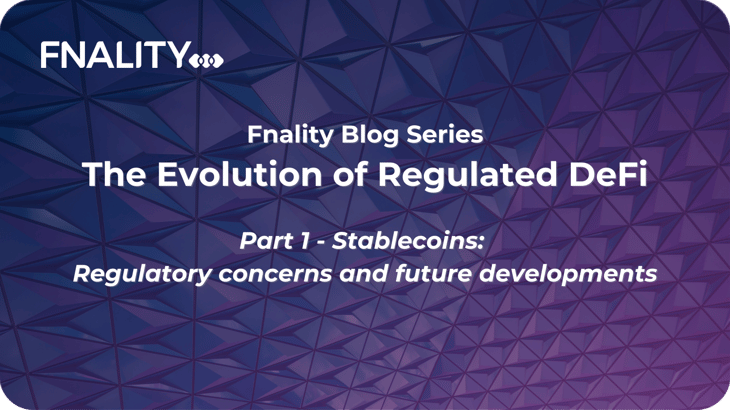
As anticipated by our CEO, Rhom Ram, in his 2021 September blog post 'Are Stablecoins a threat to Capital Markets Incumbents?', the speed of market acceptance of stablecoins has been remarkably quick and therefore constitutes a financial stability concern for regulators.
As legislative frameworks are currently under construction, stablecoin arrangements - particularly because they depend on the receipt of fiat currency to issue corresponding digital tokens in exchange - look soon to be fully treated like depositary institutions.
Unlike a stablecoin, each Fnality Payment System doesn’t create or issue novel payment instruments, but is instead designed to be the 'system operator' of assets backed 1-to-1 by central bank money and held in a central bank account. This is why Fnality Global Payments expects to be designated and regulated as an innovative systemically important payment system.
Stablecoin legislation is unlikely to apply to Fnality, but stablecoin adoption has accelerated discussions on how best to authorise and regulate the 'Decentralised Finance' (DeFi) ecosystem. The positive result of this is that regulators now really understand the growing industry need for tokenised cash and assets.
In this blog, we explore and explain concerns from regulators, and share our view on what the future looks like for stablecoins.
Regulatory concerns on stablecoins
Before delving into the different initiatives, the main topics that regulators aim to oversee are summarised below:
- Consumer protection: the holder of a stablecoin ('the consumer') deserves to be protected against a loss in value of the stablecoin. In essence, this implies that the stablecoin needs to be convertible into the reference asset (e.g. USD) at par and at short notice. To this end, the stablecoin arrangement needs to hold adequate buffers of HQLA (high-quality liquid assets) – very much like banks. Moreover, the President’s Working Group (PWG) on Financial Markets proposes stablecoin holdings should be insured like bank deposits (see next section). Securities and Exchange Commission (SEC) Chair Gary Gensler also indicated that 'stablecoins (…) may be securities, commodities and/or derivatives', making them subject to securities regulation.
- AML/ KYC (CFT): due to 'their potential for anonymity, global reach and use to layer illicit funds' stablecoins may be used to avoid traditional banking and financial systems, and facilitate illicit activities against anti-money laundering, tax compliance, and sanctions. Regulators want to make sure that criminal activities are prevented.
- Monetary Policy: Since consumers will substitute bank deposits for stablecoins and stablecoin issuers are likely to hold different assets than banks, the functioning of re-financing markets and the demand for collateral may change. This will potentially influence the implementation of monetary policy. However, central banks will always be able to keep short-term interest rates in line with their targets.
- Financial stability: loss in confidence in a very large, possibly systemically important stablecoin arrangement could lead to run on the stablecoin (similar to a run on a bank). If the stablecoin arrangement can’t honour these withdrawals, the loss of confidence may spread to other institutions (banks or other stablecoin arrangements) leading to widespread panic and loss of economic substance.
- Competition: while it is true that there is no 'long-term viability for 5,000 or 6,000 private forms of money', regulators want also to make sure that the rapid adoption of a few stablecoins won’t confer to them monopoly power over the payments system.
- Interoperability: as outlined by the ECB in a recent paper; 'as industry participants are presently building their own DLT-based systems, there is a risk of incompatibility between the different systems, potentially leading to (further) fragmentation.' Interoperability between platforms is crucial to fully unlock the benefits.
Addressing regulatory concerns on stablecoins
While a universally agreed definition is still missing, the market generally refers to stablecoins as a digital asset designed to maintain a stable value relative to a sovereign currency, in particular the U.S. dollar.[1]
This is why the USA President’s Working Group on Financial Markets released a long-awaited report to enact legislation aiming to ensure that stablecoins are subject to appropriate oversight, to ensure that such digital assets require further regulation to safeguard market integrity, to protect investors, and to prevent illicit finance. Key requirements include:
- Stablecoin issuers would be required to be insured depository institutions (in other words they will be required to become banks) to guard against stablecoin runs.
- In addition, to address concerns about payment system risks[2], custodial wallet providers would be required to be subject to appropriate federal oversight and required to meet appropriate risk-management standards.
- To safeguard against systemic risk and concentration of economic power, stablecoin issuers would be required to limit affiliation with commercial entities and observe future interoperability standards.
We anticipate to see a growth in attempts from stablecoin initiatives to become regulated entities (see Circle’s filing application).[3]
Digitisation and new technologies like DLT and blockchain have the potential to introduce significant innovation into financial markets. However, to bring new payment solutions at scale, and to fully unlock the potential of DeFi, achieving regulatory approval is key.
Where this is not achieved, the consequences have already been evidenced. The largest permissioned blockchain-based stablecoin payment system, Diem (formerly known as Libra) launched by Meta Platforms (formerly known as Facebook) has been shut down after hitting regulatory opposition.
Coming up in Part 2 of this series:
The emergence of stablecoins has pushed central banks around the world to develop and test Central Bank Digital Currency (CBDC) options.
Why? Which jurisdictions are leading the way? Are these endeavours borne out of hype, or do they have hope of becoming live, fully functional systems?
Find out more in our next blog post on The Evolution of Regulated DeFi.
[1] The 5 largest stablecoins - Tether, USD Coin, Binance USD, Dai, and TerraUSD - have reached a combined market capitalisation of around 150$bn. If ranked purely by asset size, the market would be equivalent to a top 30 US bank).
[2] Risks: Failure of stablecoins to maintain a stable value could expose stablecoin users to unexpected losses and lead to stablecoin runs that damage financial stability. Disruptions to the payment chain that allow stablecoins to be transferred among users could lead to a loss of payments efficiency and, depending on the extent to which stablecoins are used, undermine functioning in the broader economy.
[3] For more info, please read the Financial Stability Oversight Council 2121 Report on stablecoin recommendations – page 173).


